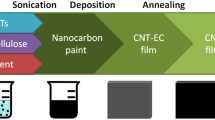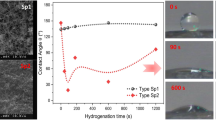Abstract
In this work, we have studied superhydrophilic and superhydrophobic transitions on the vertically aligned multiwalled carbon nanotube (VACNT) surfaces. As-grown, the VACNT surfaces were superhydrophobic. Pure oxygen plasma etching modified the VACNT surfaces to generate superhydrophilic behavior. Irradiating the superhydrophilic VACNT surfaces with a CO2 laser (up to 50 kW cm−2) restored the superhydrophobicity to a level that depended on the laser intensity. Contact angle and surface energy measurements by the sessile drop method were used to examine the VACNT surface wetting. X-ray photoelectron spectroscopy (XPS) showed heavy grafting of the oxygen groups onto the VACNT surfaces after oxygen plasma etching and their gradual removal, which also depended on the CO2 laser intensity. These results show the great influence of polar groups on the wetting behavior, with a strong correlation between the polar part of the surface energy and the oxygen content on the VACNT surfaces. In addition, the CO2 laser treatment created an interesting cage-like structure that may be responsible for the permanent superhydrophobic behavior observed on these samples.






Similar content being viewed by others
References
Baughman RH, Zakhidov AA, Heer WA (2002) Carbon nanotubes the route toward applications. Science 297:787–792
Kouklin NA, Kim WE, Lazareck AD, Xu JM (2005) Carbon nanotube probes for single-cell experimentation and assays. Appl Phys Lett 87:173901–173903
Fu Q, Liu J (2005) Integrated single-walled carbon nanotube/microfluidic devices for the study of the sensing mechanism of nanotube sensors. J Phys Chem B 109:13406–13408
Ko H, Peleshanko S, Tsukruk VV (2004) Combing and bending of carbon nanotube arrays with confined microfluidic flow on patterned surfaces. J Phys Chem B 108:4385–4393
Lobo AO, Corat MAF, Antunes EF, Palma MBS, Pacheco-Soares C, Garcia EE, Corat EJ (2010) An evaluation of cell proliferation and adhesion on vertically-aligned multi-walled carbon nanotube films. Carbon 48:245–254
Cassie ABD, Baxter S (1944) Wettability of porous surfaces. Trans Faraday Soc 40:546–551
Oner D, McCarthy TJ (2000) Ultrahydrophobic surfaces effects of topography length scale on wettability. Langmuir 16:7777–7782
Lau KS, Bico J, Teo KB, Chhowalla M, Amaratunga GAJ, Milne WI et al (2003) Superhydrophobic carbon nanotube forests. Nano Lett 3:1701–1705
Hong YC, Uhm HS (2006) Superhydrophobicity of a material made from multiwalled carbon nanotubes. Appl Phys Lett 88:244101–244104
Ge L, Sethi S, Ci L, Ajayan PM, Dhinojwala A (2008) Carbon nanotube-based synthetic gecko tapes. Nano Lett 8:822–825
Ajayan P, Ebbesen W, Ichihashi T, Iijima S, Tanigaki K, Hiuria H (1993) Opening carbon nanotubes with oxygen and implications for filling. Nature 362:522–525
Kim Y, Lee D, Oh Y, Choi J, Baik S (2006) The effects of acid treatment methods on the diameter dependent length separation of single walled carbon nanotubes. Synt Met 156:999–1003
Lakshminarayanan PV, Toghiani H, Pittman CU (2004) Nitric acid oxidation of vapor grown carbon nanofibers. Carbon 42:2433–2442
Sun T, Wang G, Liu H, Feng L, Jiang L, Zhu D (2003) Control over the wettability of an aligned carbon nanotube film. J Am Chem Soc 125:14996–14997
Kakad BA, Pillai VK (2008) Tuning the wetting properties of multiwalled carbon nanotubes by surface functionalization. J Phys Chem C 112:3183–3186
Bai X, Dan L, Du D, Zhang H, Chen L, Ji L (2002) Laser irradiation for purification of aligned carbon nanotube films. Carbon 42:2125–2127
Cheong FC, Lim KY, Sow CH, Lin J, Ong CK (2003) Large area patterned arrays of aligned carbon nanotubes by means of laser trimming. Nanotechnology 14:433–437
Ramos SC, Vasconcelos G, Antunes EF, Lobo AO, Trava-Airoldi VJ, Corat EJ (2010) CO2 laser treatment for stabilization of the superhydrophobicity of carbon nanotube surfaces. J Vac Sci Technol B 28:1153–1158
Antunes EF, Lobo AO, Corat EJ, Trava-Airoldi VJ, Martin AA, Veríssimo C (2006) Comparative study of first- and second-order Raman spectra of MWCNT at visible and infrared laser excitation. Carbon 44:2202–2211
Choi YC, Shin YM, Lim SC, Bae DJ, Lee YH, Lee BS, Chung D (2000) Effect of surface morphology of Ni thin film on the growth of aligned carbon nanotubes by microwave plasma-enhanced chemical vapor deposition. J Appl Phys 88:4898–4903
Owens DK, Wendt RC (1969) Estimation of the surface free energy of polymers. J Appl Polym 13:1741–1969
Yu MF, Lourie O, Dyer MJ, Moloni K, Kelly T, Ruoff R (2000) Strength and breaking mechanism of multiwalled carbon nanotubes under tensile load. Science 28:637–640
Rudawska A, Jacniacka E (2009) Analysis for determining surface free energy uncertainty by the Owen—Wendt method. Int J Adhes Adhes 29:451–457
Wirth CT, Hofmann S, Robertson J (2008) Surface properties of vertically aligned carbon nanotube arrays. Diam Relat Mat 17:1518–1524
Ramos SC, Vasconcelos G, Antunes EF, Lobo AO, Trava-Airoldi VJ, Corat EJ (2010) Total Re-establishment of superhydrophobicity of vertically-aligned carbon nanotubes by CO2 laser treatment. Surf Coat Tech 204:3073–3077
Mennella V, Monaco G, Colangeli L, Bussoletti E (1995) Raman spectra of carbon based materials. Carbon 33:115–121
Osswald S, Flahaut E, Ye Y, Gogotsi Y (2005) Elimination of D-band in Raman spectra of doublewall carbon nanotubes by oxidation. Chem Phys Lett 402:422–427
Compagnini G, Puglisi O, Foti G (1997) Raman spectra of virgin and damaged graphite edge planes. Carbon 35:1793–1797
Souza Filho AG, Jorio A, Samsonidze G, Dresselhaus G, Dresselhaus MS (2003) Raman spectroscopy for probing chemically/physically induced phenomena in carbon nanotubes. Nanotechnology 14:1130–1139
Rao AM, Jorio A, Pimenta MA, Dantas MSS, Saito R, Dresselhaus G, Dresselhaus MS (2000) Polarized Raman study of aligned multiwalled carbon nanotubes. Phys Rev Lett 84:1820–1823
Ya-P Sun, Fu K, Lin Y, Huang W (2002) Functionalized carbon nanotubes: properties and applications. Acc Chem Res 35:1096–1104
Ueda T, Katsuki S, Abhari NH, Ikegami T, Mitsugi F, Nakamiya T (2008) Effect of laser irradiation on carbon nanotube films for Nox gas sensor. Surf Coat Tech 202:5325–5328
Dorai R, Kushner M (2003) A model for plasma modification of polypropylene using atmospheric pressure discharges. J Phys D Appl Phys 36:666–685
Boudoua JP, Martinez-Alonzo A, Tascon JM (2000) Introduction of acidic groups at the surface of activated carbon by microwave-induced oxygen plasma at low pressure. Carbon 38:1021–1029
Hueso JL, Espinós JP, Caballero A, Cotrino J, Gonzalez-Elipe AR (2007) XPS investigation of the reaction of carbon with NO, O2, N2 and H2O plasmas. Carbon 45:89–96
Paredes JI, Martınez-Alonso A, Tascon JMD (2000) Atomic force microscopy investigation of the surface modification of highly oriented pyrolytic graphite by oxygen plasma. J Mater Chem 10:1585–1591
Estrade-Szwarckopf H (2004) XPS photoemission in carbonaceous materials: a ‘‘Defect’’ peak beside the graphitic asymmetric peak. Carbon 42:1713–1721
Liu M, Yang Y, Zhu T, Liu Z (2005) Chemical modification of single-walled carbon nanotubes with peroxytrifluoroacetic acid. Carbon 43:1470–1478
Barthlott W, Schimmel T, Wiersch S, Koch K, Brede M, Barczewski M, Kaltenmaier A, Leder A, Bohn HF (2010) The Salvinia paradox: superhydrophobic surfaces with hydrophilic pins for air retention under water. Adv Mater 22:2325–2328
Acknowledgments
This work was supported by FAPESB (720/2009) and FAPESP (07/00013-4, 06/03525-3 and 2008/11642-5) and UNEB. Special thanks to Maria Lucia Brison (LAS/INPE) by the SEM images, and Marcelo E. H. Maia da Costa (PUC/Rio) by XPS spectra.
Author information
Authors and Affiliations
Corresponding author
Additional information
Dedicated to Professor Akira Imamura on the occasion of his 77th birthday and published as part of the Imamura Festschrift Issue.
Rights and permissions
About this article
Cite this article
Ramos, S.C., Lobo, A.O., de Vasconcelos, G. et al. Influence of polar groups on the wetting properties of vertically aligned multiwalled carbon nanotube surfaces. Theor Chem Acc 130, 1061–1069 (2011). https://doi.org/10.1007/s00214-011-0984-y
Received:
Accepted:
Published:
Issue Date:
DOI: https://doi.org/10.1007/s00214-011-0984-y




